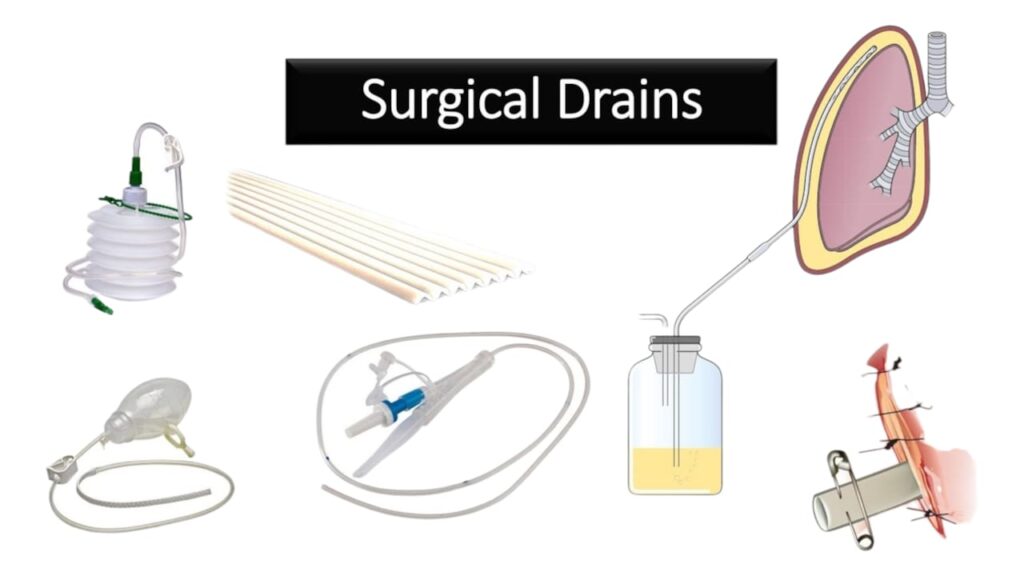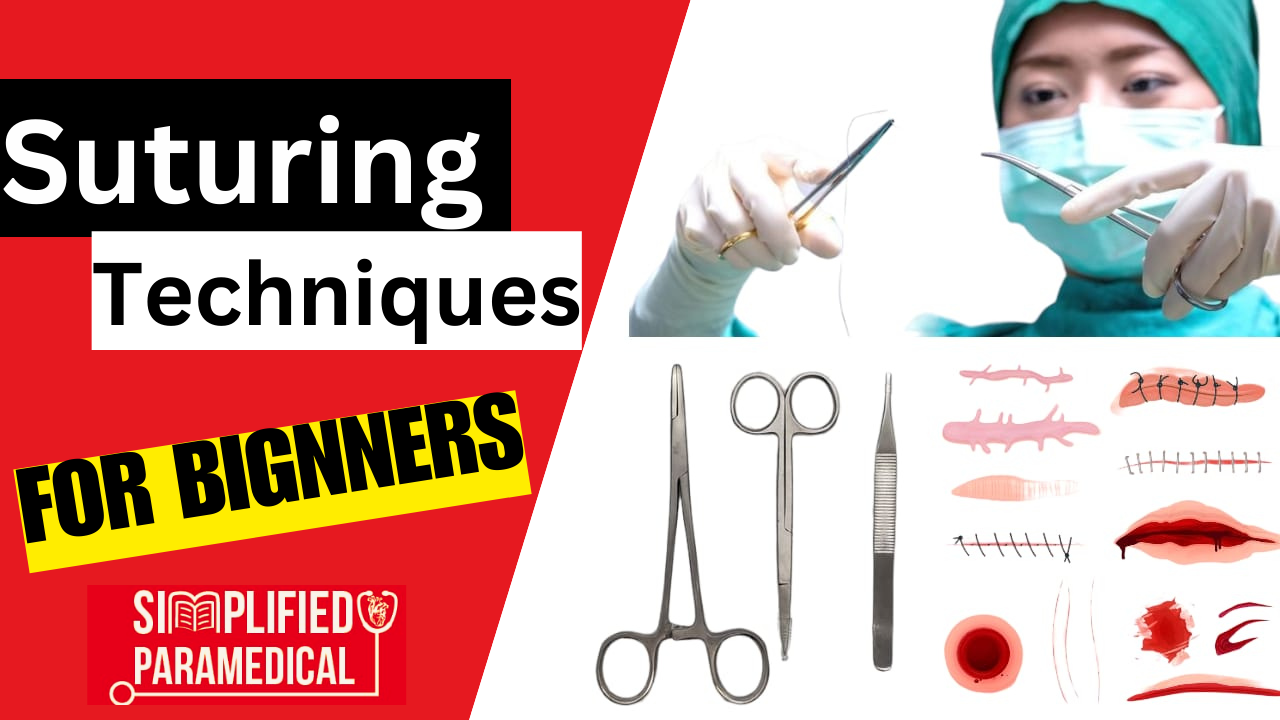1. Definition
A surgical drain is a medical device used to remove fluid or air from a wound or body cavity after surgery or injury· Here’s a simple explanation:
Table of Contents
Purpose:
After surgery, fluid (such as blood or lymph) or air may collect in the surgical site or body cavity, leading to swelling, discomfort, and increased risk of infection· A surgical drain helps remove this fluid or air, promoting healing and reducing the risk of complications·
2· Functions Of Drain
•A surgical drain typically consists of a flexible tube or catheter inserted into the surgical site or body cavity·
•The tube is connected to a collection bag or bulb outside the body, which collects the fluid or air being drained·
•As the body produces fluid or air, it drains through the tube and into the collection device, where it can be measured and disposed of·
3.Types of Surgical Drains
A. Based on Mechanism of Action:
Passive Drains:
Jackson-Pratt (JP) Drain:
Working Principle: The JP drain operates passively by utilizing external compression to create negative pressure inside the bulb or reservoir· As the compressed bulb expands, it creates suction, drawing fluid from the wound into the collection device·
Usage: The JP drain is commonly used in various surgical procedures, including abdominal, orthopedic, and plastic surgeries·
Reasons for Use:
The JP drain is effective for removing moderate to large amounts of fluid from the surgical site·
It allows for easy monitoring and measurement of drainage output, facilitating early detection of complications such as infection or hematoma·
The JP drain helps prevent the accumulation of fluid, reducing the risk of seroma formation and promoting wound healing·
Jackson-Pratt (JP) Drain:
Working Principle: The JP drain operates passively by utilizing external compression to create negative pressure inside the bulb or reservoir· As the compressed bulb expands, it creates suction, drawing fluid from the wound into the collection device·
Usage: The JP drain is commonly used in various surgical procedures, including abdominal, orthopedic, and plastic surgeries·
Reasons for Use:
The JP drain is effective for removing moderate to large amounts of fluid from the surgical site·
It allows for easy monitoring and measurement of drainage output, facilitating early detection of complications such as infection or hematoma·
The JP drain helps prevent the accumulation of fluid, reducing the risk of seroma formation and promoting wound healing·
Penrose Drain:
Working Principle: The Penrose drain operates passively by allowing fluid to drain from the wound along the surface of the drain· It relies on gravity and capillary action for fluid removal·
Usage: Penrose drains are commonly used in surgical procedures where passive drainage is sufficient, such as appendectomies, abscess drainage, and open wound management·
Reasons for Use:
Penrose drains are flexible and easily adaptable to various wound shapes and sizes·
They are suitable for wounds with minimal to moderate drainage and where active suction is not required·
Penrose drains minimize tissue trauma and discomfort compared to more invasive drainage systems·
Hemovac Drain:
Working Principle: The Hemovac drain operates actively by using a spring-loaded vacuum bottle or reservoir to create suction· The compressed reservoir expands after placement, creating negative pressure and drawing fluid from the wound into the collection device·
Usage: Hemovac drains are commonly used in surgical procedures where continuous suction drainage is needed, such as mastectomies, orthopedic surgeries, and trauma cases·
Reasons for Use:
Hemovac drains provide reliable suction for efficient removal of large volumes of fluid, blood, or serous exudate from the surgical site·
They help reduce the risk of hematoma formation, infection, and wound complications by promoting effective drainage and wound healing·
Hemovac drains are easy to use and maintain, allowing for accurate monitoring of drainage output and early detection of postoperative complications·
Closed-Suction Drains:
Working Principle: Closed-suction drains utilize a sealed system with a vacuum source to provide constant suction for fluid removal· They can be silicone drains with multiple perforations or specially designed drains with built-in suction mechanisms·
Usage: Closed-suction drains are used in surgical procedures where continuous and controlled suction drainage is necessary, such as abdominal surgeries, thoracic surgeries, and complex wound management·
Reasons for Use:
Closed-suction drains offer superior suction control and efficiency compared to passive drains·
They help prevent the formation of seromas, hematomas, and infections by continuously removing fluid and debris from the surgical site·
Closed-suction drains reduce the need for frequent dressing changes and minimize the risk of contamination and wound-related complications·
B. Based on Design:
Open Drains:
Open drains are simple tubes or catheters with one end placed inside the wound or body cavity and the other end exiting the skin· They allow fluid to flow freely into an external dressing or collection device·
Closed Drains:
Closed drains have a sealed system that prevents external contaminants from entering the wound· They may have a reservoir or collection device attached to the end of the drain to collect fluid or air·
C. Based on Location of Placement:
Intraperitoneal Drains:
Working Principle: Intraperitoneal drains are placed inside the peritoneal cavity during abdominal surgery· They utilize gravity and capillary action to passively remove fluid or pus from the peritoneal cavity·
Usage: These drains are commonly used after procedures such as appendectomy, bowel resection, or abdominal trauma where there is a risk of intra-abdominal fluid collection·
Reasons for Use:
Intraperitoneal drains help prevent the accumulation of fluid or pus within the peritoneal cavity, reducing the risk of infection, abscess formation, and intra-abdominal adhesions·
They facilitate the drainage of postoperative serous exudate, blood, or bile leakage, promoting wound healing and preventing complications such as peritonitis or sepsis·
Intraperitoneal drains allow healthcare providers to monitor and quantify the amount of drainage, facilitating early detection of complications and adjustment of postoperative management·
Intrathoracic Drains:
Working Principle: Intrathoracic drains are inserted into the pleural cavity to remove air or fluid after thoracic surgery or trauma· They utilize gravity and negative pressure to actively drain air or fluid from the pleural space·
Usage: These drains are often used in cases of pneumothorax, hemothorax, pleural effusion, or thoracic surgery where there is a risk of pleural space accumulation·
Reasons for Use:
Intrathoracic drains help re-expand the collapsed lung by removing air or fluid from the pleural space, improving respiratory function and preventing complications such as respiratory distress or tension pneumothorax·
They facilitate the drainage of postoperative blood, air, or inflammatory fluid, reducing the risk of pleural space infection, empyema, or fibrothorax·
Intrathoracic drains allow for continuous monitoring of pleural fluid or air drainage, enabling prompt intervention in case of significant fluid accumulation or air leak·
Subcutaneous Drains:
Working Principle: Subcutaneous drains are placed beneath the skin to remove fluid from subcutaneous spaces· They utilize gravity and passive drainage to remove fluid from the surgical site·
Usage: These drains are commonly used after procedures such as mastectomy, abdominoplasty, or liposuction where there is a risk of subcutaneous fluid accumulation·
Reasons for Use:
Subcutaneous drains help prevent the buildup of seroma or hematoma by facilitating the removal of excess fluid from the surgical site, promoting wound healing and preventing complications such as infection or skin necrosis·
They reduce the risk of cosmetic deformity or contour irregularities by preventing fluid accumulation and tissue distortion in the subcutaneous space·
Subcutaneous drains allow for accurate monitoring of postoperative drainage, enabling healthcare providers to assess wound healing progress and detect complications such as lymphatic leakage or delayed wound healing·
D. Based on Material:
Silicone Drains:
Silicone drains are made of soft, flexible silicone material· They are biocompatible and less likely to cause tissue irritation compared to latex drains· Silicone drains are commonly used in various surgical procedures·
Latex Drains:
Latex drains are made of latex rubber, which is flexible and economical· However, some individuals may have latex allergies, and latex drains may cause tissue irritation or allergic reactions.
4. Monitoring and Caring of Surgical Drains
Monitoring the Drainage:
- Healthcare providers regularly monitor the amount and nature of fluid or air draining from the wound or body cavity through the surgical drain·
- This monitoring helps assess the effectiveness of drainage, detect any abnormalities or complications early, and guide postoperative management·
- Providers may measure the output of drainage at scheduled intervals, typically recorded in milliliters (ml) or cubic centimeters (cc)· This measurement helps track the progress of drainage and identify any sudden changes that may indicate a problem·
- Additionally, healthcare providers assess the color, consistency, and odor of the drained fluid· Changes in these characteristics may indicate infection, bleeding, or other complications that require further evaluation and intervention·
Proper Care of the Surgical Drain:
- Proper care of the surgical drain is essential to prevent infection and ensure effective drainage·
- Emptying the Collection Device: Healthcare providers regularly empty the collection device attached to the surgical drain to prevent overfilling and maintain optimal drainage·
- Cleaning the Collection Device: The collection device should be cleaned regularly to prevent contamination and infection· This typically involves emptying the device, rinsing it with warm water or a prescribed solution, and drying it thoroughly before reuse·
- Securing the Drain: The surgical drain should be securely anchored to the skin using sutures, adhesive dressings, or other securing devices to prevent accidental dislodgement and ensure continuous drainage·
- Monitoring the Exit Site: Healthcare providers inspect the exit site of the drain for signs of infection, such as redness, swelling, warmth, or drainage· Any abnormalities should be reported and promptly addressed to prevent complications·
- Assessing Drain Patency: Providers ensure that the surgical drain remains patent and free of obstructions by checking for kinks, twists, or blockages in the tubing· Any obstructions should be cleared to maintain proper drainage·
- Educating the Patient: Patients and caregivers are educated on how to care for the surgical drain at home, including emptying the collection device, cleaning the exit site, and recognizing signs of complications· They should also be instructed on when to seek medical attention if concerns arise·






